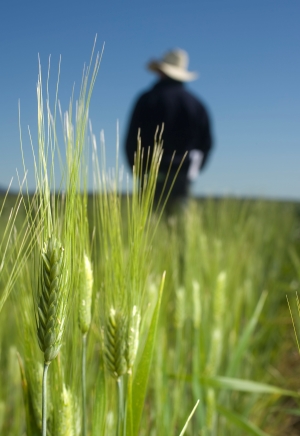
A new report has revealed a strong correlation between Australian grains production and jobs in regional areas – about one job for every 1000 tonnes of grain produced.
The Grains Research and Development Corporation (GRDC) report 'The Grains Industry's Value in Regional Economies' outlines research conducted, with GRDC investment, by the Regional Australia Institute.
GRDC head of industry and government relations, Justin Crosby, says grains comprise about a quarter of the value of Australia's agricultural industry.
"The GRDC's core business is about investing in research, development and extension (RD&E) to give Australian grain growers the tools they need to be profitable," he said.
"This report clearly shows that grain growers are the backbone of many of Australia's regional economies and demonstrates the critical importance of ensuring that they continue to be profitable."
Mr Crosby says the findings show there is one grain production job for every 1196 tonnes of Australian grain produced.
"The number of grain production jobs – people involved in the growing of grain, which may be in combination with the production of other crops and livestock – increases with raw grain tonnage and gross value," he said.
"For every 100,000 tonnes of grain produced there are, on average, 87 grain production jobs in the northern growing region (Queensland and New South Wales); 121 in the southern region (Victoria, South Australia and Tasmania); and 54 in the western region (Western Australia).
"Grain worth $10 million in gross value generates, on average, 22 grain production jobs in the northern growing region, 41 jobs in the southern region and 17 jobs in the western region."
Mr Crosby said there were 34,745 direct grain production jobs at the time of the last Census, with the bulk being in NSW (29 per cent) and WA (23 per cent), followed by SA, Victoria, Queensland and Tasmania.
"At a local government level Toowoomba (Queensland), Western Downs (Queensland), Moree Plains (NSW), Yorke Peninsula (SA) and Esperance (WA) had the most grain production jobs," he said.
Mr Crosby said while the grains industry continued to be a significant source of Australian employment, the number of grain production jobs fell from 50,707 jobs in the 2006 Census to 34,745 grain production jobs in 2016.
"In the face of tight labour markets in regional Australia, grain growers have been able to adapt through adopting improved technologies and achieving increased efficiencies," he said.
Mr Crosby said that while it was important to understand the total number of grain production jobs in regional Australia, it was also necessary to understand what proportion of jobs were in grain production in local areas compared with jobs in other industries.
"Regions with a high proportion of grain production jobs, compared with the national average, have a specialisation in grain production and are more dependent on the success of the grains industry for economic outcomes," he said.
"These 'specialised regions' are strongly concentrated in the WA wheatbelt, the Yorke and Eyre peninsulas in SA, the Grampians region in Victoria, central NSW and inland south-west Queensland.
"Of these, the five local government areas with the greatest specialisation in grain production are all in WA and include Kent, Mount Marshall, Kulin, Dumbleyung and Narembeen – this is where grain production accounts for the highest proportion of local jobs and is most important to the local economy."
The information in 'The Grains Industry's Value in Regional Economies' is based on information from the most recent Australian Bureau of Statistics Census of Population and Housing (2016), the Australian Bureau of Statistics Agricultural Census (2015-16) and grower interviews.
Grain Research and Development Corporation (GRDC)
The Grains Research and Development Corporation (GRDC) is one of the world's leading grains research organisations, responsible for planning, investing in and overseeing RD&E to deliver improvements in production, sustainability and profitability across the Australian grains industry. GRDC's purpose is to invest in RD&E to create enduring profitability for Australian grain growers.
Regional Australia Institute
Independent and informed by both research and ongoing dialogue with the community, the Regional Australia Institute (RAI) develops policy and advocates for change to build a stronger economy and better quality of life in regional Australia – for the benefit of all Australians. The RAI was established with support from the Australian Government.






